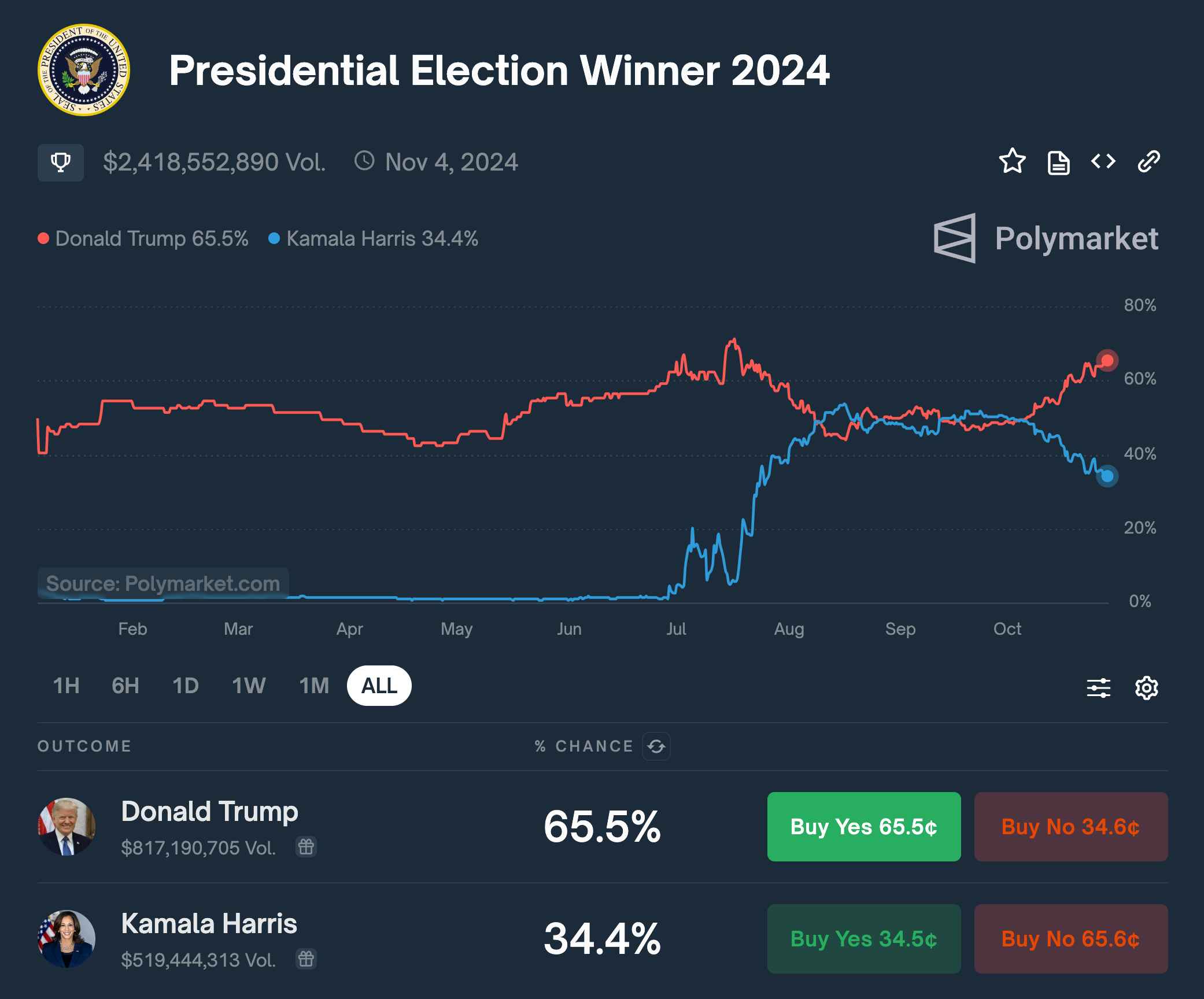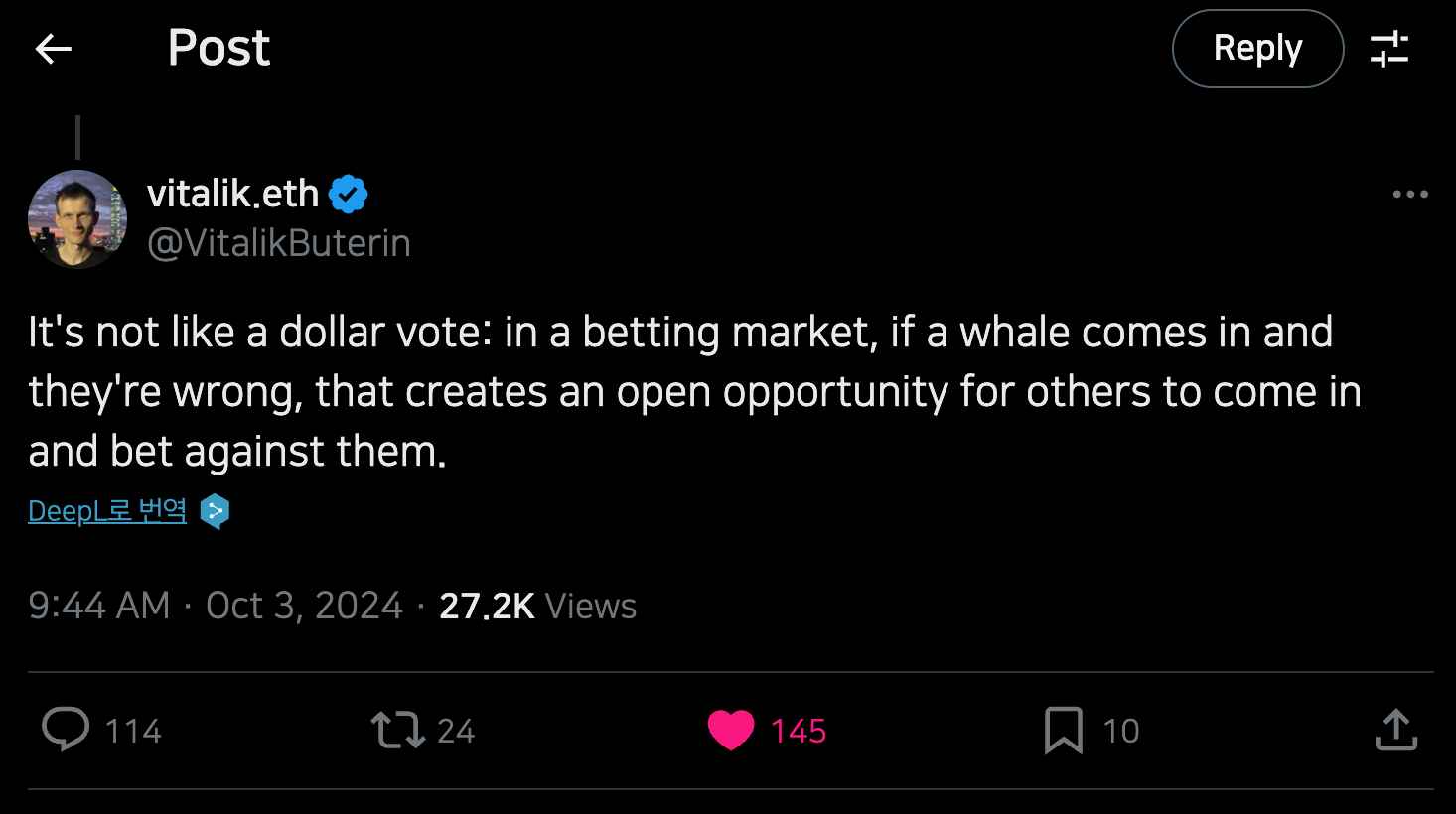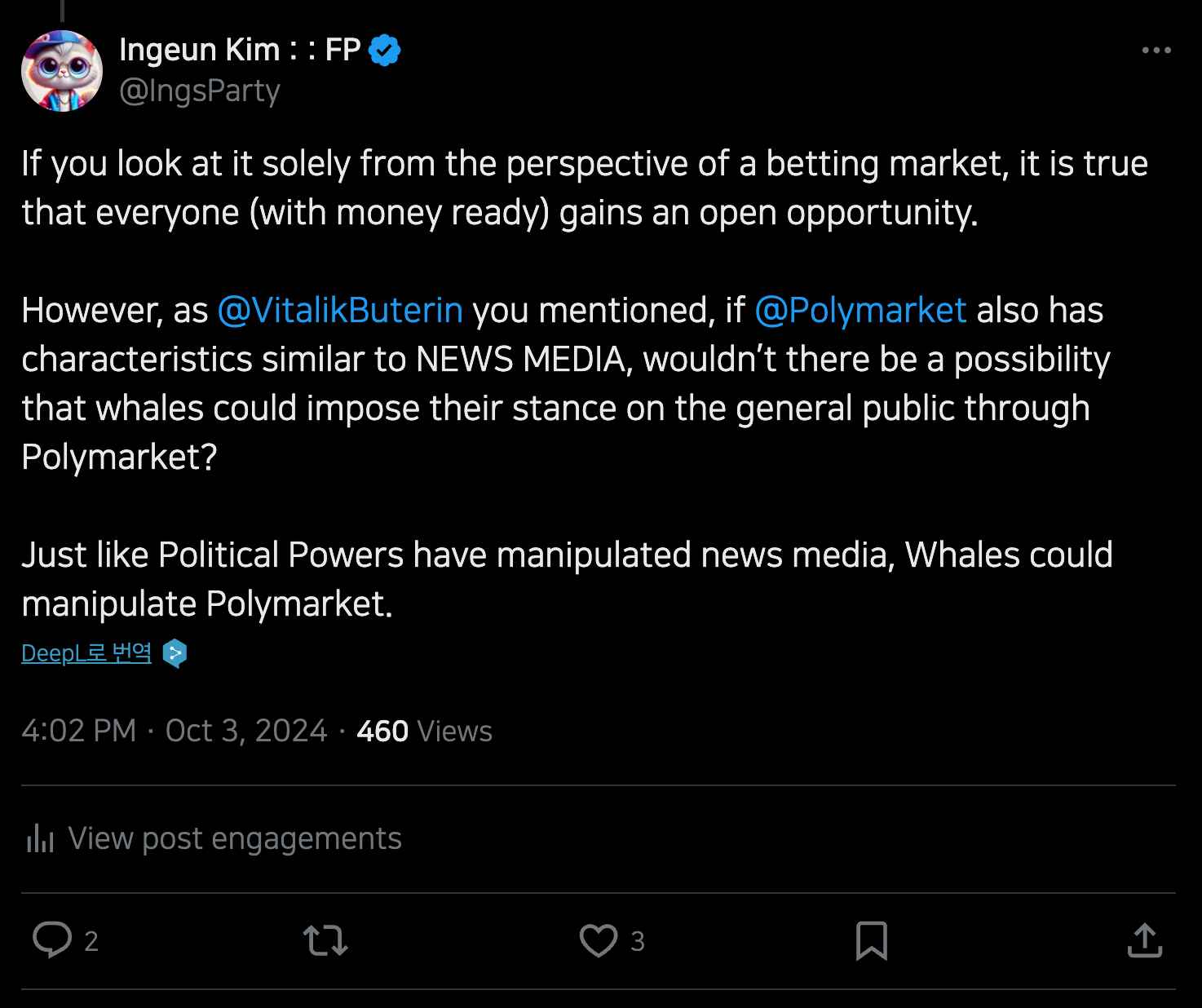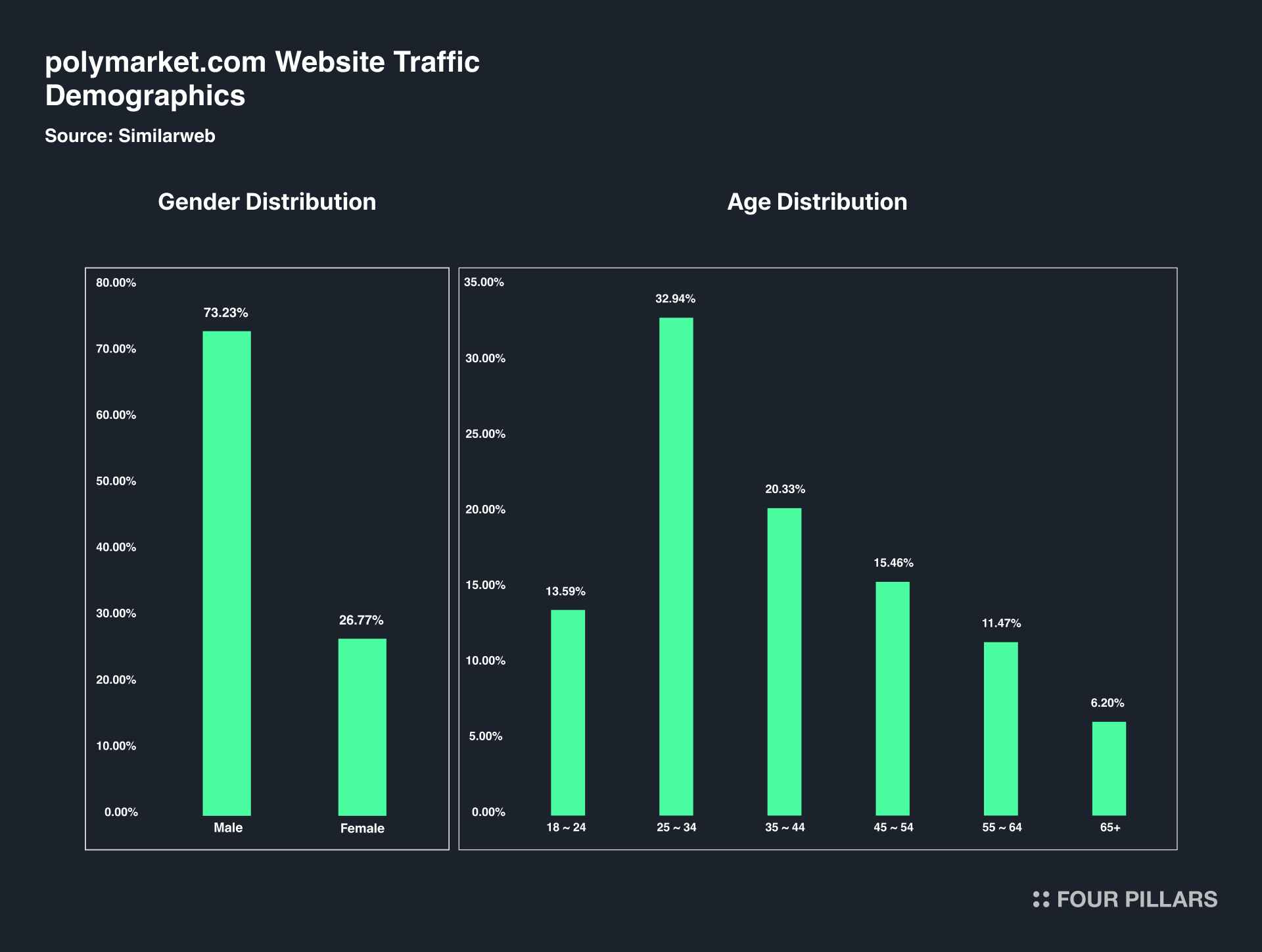
Source: Polymarket X
With the U.S. election and various sports events on the horizon, Polymarket has been a hot topic lately. As a leading on-chain prediction market platform, Polymarket enables users to bet on the outcomes of real-world events, including politics, sports, and the economy, leveraging blockchain (Polygon) technology. The platform offers a way to profit from accurate predictions, serving as an objective tool for gauging public opinion. (For more, see Four Pillars’ article)

Source: Presidential Election Winner 2024 | Polymarket
Among Polymarket’s most discussed topics is the U.S. presidential election. Recent prediction data from the platform indicates Trump leading by a wide margin. After Biden announced his withdrawal on July 21, 2024, betting data predicting a win for Harris fluctuated, with a tight race continuing on Polymarket until early October. However, as of October 28, 2024, the odds show a stark contrast, with Trump at 65.5% and Harris at 34.4%. This suggests that Polymarket users believe Trump is far more likely to win than Harris.
However, as with any opinion polling, questions remain about the accuracy of Polymarket’s data. There are also rumors suggesting that this data might be manipulated. In response, Kalshi founder Tarek Mansour dismissed these claims, arguing that Polymarket’s data is not manipulated. Mansour cited data from Kalshi, another prediction market platform, to refute allegations that large investors are distorting the market in Trump’s favor, arguing that “Prediction markets are the new source of truth, free from bias."
As Mansour suggested, I also believe that Polymarket’s data is not manipulated, though I would clarify that the system itself has not been tampered with. Polymarket’s use of blockchain for data recording means that data manipulation within the system is virtually impossible. The data displayed on Polymarket’s interface reflects real user bets recorded on the blockchain. This implies that the operators of Polymarket cannot arbitrarily alter the recorded data.
However, while blockchain data cannot be manipulated, it is hard to conclude definitively that Polymarket’s data is entirely free of external influence. Blockchain is essentially a recording system. While it ensures the integrity and reliability of on-chain data, it does not validate or verify the accuracy of off-chain data input. (This is known as the oracle problem in the blockchain industry.)
Therefore, if a user strategically placed large bets on one side, this could influence the overall prediction outcomes, even though the on-chain data itself is not manipulated.
Although rumors of manipulation may be easily dismissed, it is worth considering these issues seriously. The potential for betting influence by external actors can impact Polymarket’s accuracy. I see three factors that could contribute to the manipulation of Polymarket’s betting data.
2.2.1 Manipulation by Strategic Actors

Source: Vitalik Buterin X
Vitalik Buterin, who sees Polymarket positively, has argued that while external influences may exist, actors wishing to manipulate opinion would still have to put in their own money. Consequently, Buterin believes this self-corrective market mechanism would naturally counteract manipulation.

Source: Ingeun Kim X
However, I hold a different view. Polymarket, as a prediction market platform with growing user engagement, now functions almost like a news media outlet. This means that the outcomes predicted through betting could form a feedback loop, potentially influencing real-world outcomes. With this power, influential actors with significant capital might find it worthwhile to alter opinion trends, beyond what Buterin’s self-correcting mechanism could counteract.
In the case of high-stakes topics like the U.S. presidential election, where monetary incentives abound, entities seeking to steer public opinion by controlling betting trends will likely persist. A clear example is the 2016 U.S. election, in which Russia manipulated public opinion through social media misinformation. The Russian Internet Research Agency (IRA) spread false information targeting African American voters, misleading them to abstain or vote for a third-party candidate. Misleading campaigns, like “Vote by Text,” also aimed to misinform and disenfranchise voters, ultimately affecting the election.
Looking at Polymarket, similar external interference could alter betting trends, possibly diverging from honest public sentiment. Furthermore, the greater the issue’s impact, the less reliable user-driven corrections will be.
2.2.2 Unintentional Manipulation of Betting Trends
Another form of betting influence can occur simply due to Polymarket’s betting-based structure. Users on Polymarket are betting to make money, and while most users bet for fun, no one wants to place bets that might lead to losses.
This mentality can lead to unintentional bias in betting trends. Take the U.S. election for example: between August and September, when the race was close, it was unclear which side would yield profit. But now, with the gap significantly widened, betting on Trump has become the safer choice. Users driven by monetary incentives alone might skew the predictions, showing more support for Trump than other opinion polls.
Ultimately, this tendency to favor certain bets for profit can lead Polymarket’s data to reflect less accurate public opinion trends.
2.2.3 Polymarket’s Accessibility
Finally, there is the issue of Polymarket’s accessibility. Although Polymarket’s interface is designed to be user-friendly, the platform remains largely unrecognized by the general public. Its cutting-edge technology and reliance on blockchain mean that user demographics tend to be narrow.

According to Polymarket’s user data, about 58% of traffic comes from the U.S., followed by Canada, the U.K., Switzerland, and Korea. The majority of users are between 25–34 years old, with approximately 73% male and 27% female.
This user concentration could skew the accuracy of Polymarket’s public opinion data. For example, in the case of U.S. election bets, only 58% of users are American, meaning the remaining 42% are from countries without a direct stake in the U.S. election. Additionally, the user base leans heavily male and is concentrated in the 20s and 30s age range, leading to potential political bias.
Though not intentional, this narrow user base means that Polymarket’s data may lack representation, impacting its prediction accuracy.
There’s an old saying that “money doesn’t lie,” which has resonated across cultures. However, while money itself may not lie, those who control it certainly can. This issue contributes to Polymarket’s prediction inaccuracy. With various actors seeking monetary gain or influence, Polymarket’s data does not necessarily reflect accurate public sentiment.
To be fair, these external factors are largely beyond Polymarket’s control, and Polymarket could argue that they are simply part of the broader opinion landscape. Additionally, as a prediction market platform, Polymarket benefits from increased capital and traffic. However, if Polymarket’s data consistently diverges from actual outcomes, it risks losing user engagement, diminishing its appeal as a prediction platform.
With Polymarket rapidly expanding and gaining interest, it would be interesting to see how the platform addresses these challenges. Polymarket has no obligation to achieve perfect prediction accuracy, given its focus on opinion polling. Yet, by addressing these issues with a long-term perspective, Polymarket could emerge as a highly credible on-chain prediction market platform. Personally, I hope Polymarket continues to grow and becomes a definitive use case for the blockchain industry.
Polymarket has frequently encountered issues regarding the reliability of verdicts on controversial topics, such as the outcome of the Venezuelan presidential election, whether Trump will launch a coin, and the recent speculation on Israeli military action against Iraq. Given these instances, it appears that Polymarket could benefit from improvements to uphold its fairness and trustworthiness as a prediction market platform.
Currently, Polymarket employs UMA's oracle, which uses a voting mechanism to verify data. However, this structure, where UMA token holders have decision-making power, is susceptible to manipulation based on capital strength, especially as UMA's market cap is considerably smaller than Polymarket’s trading volume. With Polymarket’s monthly trading volume exceeding 2 billion USD and UMA’s market cap at only 200 million USD, this disparity leaves room for potential influence over verdicts.
Therefore, to ensure sustainable growth and long-term credibility as a prediction market platform, Polymarket may need to explore oracle improvement measures. Possible options could include implementing a multi-oracle system similar to multisig wallets or requiring additional verification from trusted institutions for final judgments.
Related Articles, News, Tweets etc. :
Dive into 'Narratives' that will be important in the next year